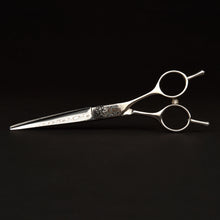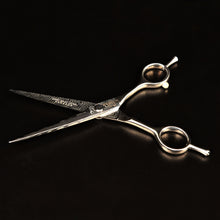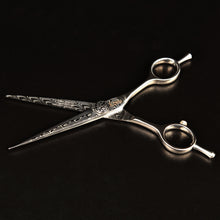The Classic Master scissors are a symbol of artistry and precision—handcrafted with the same revered techniques that legendary samurai blacksmiths used to forge their swords. This time-honored craft has been passed down through generations, and I am incredibly honored to have visited the workshops of these esteemed masters, where I witnessed the transformation of raw minerals and rocks into finely sculpted metal blades.
The Classic Master scissors are not just tools; they are the result of a unique design—a pair of mini saws fused together, creating a tool of extraordinary durability and precision. The blades are forged by melting and combining various metals and alloys, such as steel and iron, in a charcoal fire. This process infuses the metals with high carbon content from the charcoal while preventing exposure to atmospheric oxygen, resulting in a steel of exceptional strength and resilience.
At the heart of the Classic Master scissors is Damascus steel—an ancient and revered metal alloy. By melting iron and steel together with charcoal in a controlled, low-oxygen atmosphere, the metal absorbs carbon from the charcoal, creating a steel that is both hard and flexible. This process was used to forge not only swords but also tools like scissors, which required the same combination of strength and flexibility.
Historically, Damascus steel was believed to have been first made near Damascus, Syria, from as early as 900 AD, continuing until the 18th century. However, it was perfected by the samurai blacksmiths of Japan, who refined it into the formidable steel used to craft legendary blades. Known for its distinctive, watery or wavy pattern, Damascus steel is as visually captivating as it is functional. Its ability to maintain a razor-sharp edge, combined with its hardness and flexibility, made it ideal for crafting tools that were far superior to those made from ordinary metals.
The process of tempering the blade is nothing short of spectacular: the metal is heated to over 2,300°F until it glows like the desert sun, then rapidly cooled in various liquids. It is said that some samurai believed cooling the steel in the blood of a strong warrior would imbue the blade with their spirit. Once cooled, the metal is repeatedly hammered at around 1,700°F—sometimes for days on end—creating hundreds of layers that contribute to the blade’s extraordinary strength and resilience. The layering process also ensures that the steel remains flexible enough to withstand the rigors of use without becoming brittle.
Damascus steel is divided into two authentic types: cast Damascus steel and pattern-welded Damascus steel. However, in recent years, other methods have been employed to create the signature wavy pattern, using softer and more affordable metals. While these replicas may resemble the pattern of Damascus steel, they lack the true strength, durability, and history of the original. This is why some lower-cost products may look similar but are ultimately far less durable and capable.
The E. Beu Classic Master Damascus Scissors are an evocative work of art, a true testament to the enduring legacy of Damascus craftsmanship. Their beauty is not just in their appearance but in the way they feel—the weight, the balance, the precision with which they perform. They aren’t just scissors; they are a tool of craftsmanship and elegance, infused with centuries of tradition. You are drawn to them not just for their beauty but for the experience they provide—an intimate connection with a rich history of artistry and strength. With every cut, you will feel the power of generations of masters who have forged their legacy into the very blades you hold.
Inventory Last Updated: Apr 04, 2025






